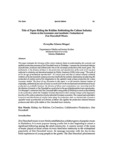Please use this identifier to cite or link to this item:
https://cris.library.msu.ac.zw//handle/11408/1844Full metadata record
| DC Field | Value | Language |
|---|---|---|
| dc.contributor.author | Mugari, Zvenyika E. | - |
| dc.date.accessioned | 2016-10-18T09:14:45Z | - |
| dc.date.available | 2016-10-18T09:14:45Z | - |
| dc.date.issued | 2016 | - |
| dc.identifier.issn | 1815-9036 | - |
| dc.identifier.uri | http://hdl.handle.net/11408/1844 | - |
| dc.description.abstract | This paper evaluates the relevance of the culture industry thesis in understanding the economic and aesthetic production processes of Zim Dancehall music in Zimbabwe. It assesses the contractual relations of production, producers and artistes enter into in the successful production of the music genre. The problematic in the division of labour in the production and reproduction of the work of art was first subjected to scholarly and theoretical analysis by Walter Benjamin (1936) in his essay: “The work of art in the age of mechanical reproduction”. Its critical focus and that of critical cultural scholarly tradition of the late twentieth century concerned itself with the aesthetic implications of subjecting the production of creative work of the imagination to the capitalist mode of mass production for a mass consumer market. The focus of my discussion in this paper is on the tensions between notions of originality, authenticity and aura of music as a work of art on the one hand and considerations of music production as profitable business; the division of labour and contestations over ownership and the distribution of rewards in Zim Dancehall as a work of art in the age of digital and electronic reproduction. It is this paper’s contention that Zim Dancehall offers many points of similarity as much as dissimilarity to the world about which the Frankfurt Scholars theorised in their seminal critique of the hegemonic function of the culture industries of early industrial European economies. The unequal and exploitative extraction and distribution of surplus value along the production chain so characteristic of moderncapitalist mode of production and division of labour also typifies the production relations between producers and riders of the riddim in Zim Dancehall music industry. | en_US |
| dc.language.iso | en | en_US |
| dc.publisher | Midlands State University | en_US |
| dc.relation.ispartofseries | The Dyke;Special edition; p. 82-99 | - |
| dc.subject | Riding the Riddim; Co-Creation; Collaborative Production; Zim Dancehall | en_US |
| dc.title | Riding the riddim: rethinking the culture industry thesis in the economic and aesthetic production of Zim dancehall music | en_US |
| dc.type | Article | en_US |
| item.languageiso639-1 | en | - |
| item.openairetype | Article | - |
| item.fulltext | With Fulltext | - |
| item.cerifentitytype | Publications | - |
| item.openairecristype | http://purl.org/coar/resource_type/c_18cf | - |
| item.grantfulltext | open | - |
| Appears in Collections: | Research Papers | |
Files in This Item:
| File | Description | Size | Format | |
|---|---|---|---|---|
| culture industry.pdf | Full Text | 13.97 MB | Adobe PDF |  View/Open |
Page view(s)
194
checked on Dec 6, 2025
Download(s)
180
checked on Dec 6, 2025
Google ScholarTM
Check
Items in MSUIR are protected by copyright, with all rights reserved, unless otherwise indicated.



